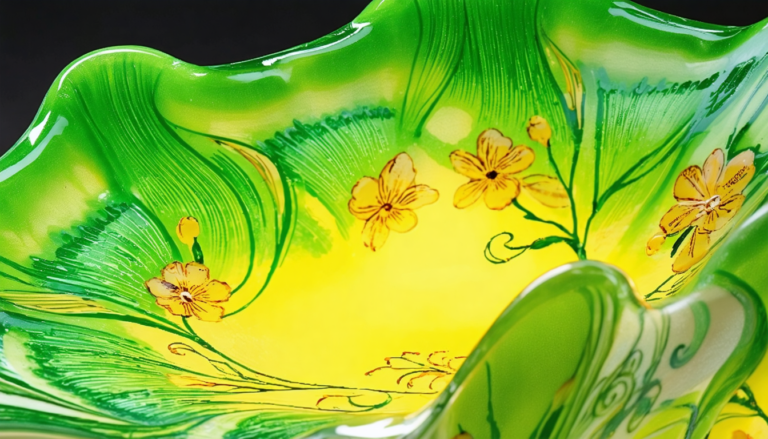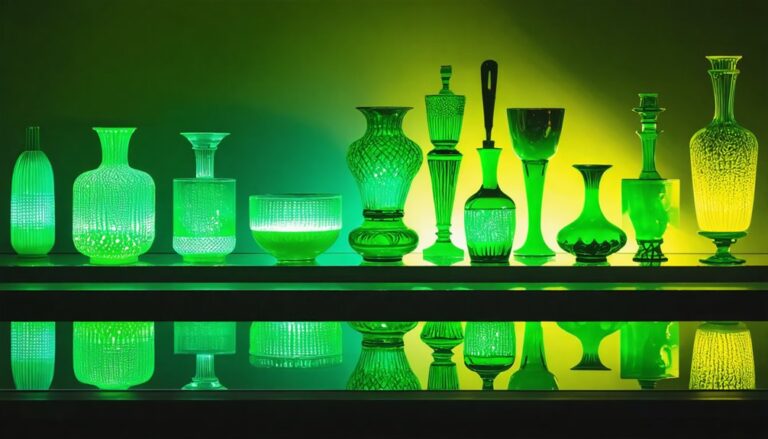Medical Applications of Uranium Glass in the 19th Century

In the late 19th century, uranium glass became a trendy medical treatment. Its bright fluorescent glow caught people’s attention. Many believed it had healing properties connected to the recent discovery of radioactivity. Influenced by scientists like Henri Becquerel and Marie Curie, some doctors started recommending uranium glass to boost energy and fight fatigue.
Health resorts, especially the famous radium spa in Joachimsthal, began using uranium-infused waters and devices in their treatments. This attracted wealthy patients seeking wellness. However, as time went on, concerns about the safety of uranium glass began to surface. These debates were crucial and led to important discussions about medical practices in the future.
Key Takeaways
Uranium glass found its way into medical practices in the 19th century. People believed it could help improve health and energy. Spa waters and mineral baths often included uranium glass, thought to rejuvenate the body.
Health resorts like Joachimsthal became well-known for their spa treatments. They used radium-infused waters, which included uranium glass, to attract visitors looking for healing.
In the early days of medical imaging, scientists experimented with uranium glass. Its unique glowing properties made it useful for diagnostic radiography. Practitioners believed it could help diagnose various health issues.
Doctors promoted uranium glass as a remedy for physical fatigue and mental exhaustion. They claimed it could aid in treating different medical problems.
Uranium glass played a key role in the beginnings of radiation therapy. Medical professionals looked to harness its natural radioactivity for therapeutic purposes. This marked an interesting chapter in the history of medical treatment.
Early Beliefs in Uranium Glass Therapy
Uranium glass appeared in the 19th century as a novel idea for health treatment. People believed that the glass, containing uranium, could enhance health and vitality. At that time, radioactivity was a fascinating new concept in medicine. This excitement led to strong beliefs in the healing properties of uranium glass.
Health resorts became popular, especially in Joachimsthal. Wealthy individuals flocked to these places, eager to experience the supposed benefits of mineral therapy. Advocates of uranium glass promoted it in various medical devices. They were convinced that its radioactive energy could restore tired minds and fatigued bodies.
The discovery of radioactivity in 1896 inspired medical pioneers. They began exploring radiation therapy, building on the early beliefs surrounding uranium glass. This exploration eventually led to the development of radium treatments, aimed at addressing various health issues.
Prominent Practitioners and Advocates
Early excitement about uranium glass therapy grew stronger because of well-known practitioners and supportive scientists. As I delved deeper, I discovered trailblazers like Henri Becquerel and Marie and Pierre Curie. Their pioneering research on uranium and radioactivity caught the medical community’s attention.
These respected figures strongly advocated for radiation therapy, showcasing uranium glass and its glowing qualities for both diagnosis and treatment.
Respected pioneers passionately promoted radiation therapy, highlighting uranium glass’s radiant properties for innovative diagnostic and treatment practices.
Soon, prominent health facilities, like the radium spa in Joachimsthal, drew wealthy patients seeking cutting-edge medical solutions for their health issues.
With ongoing advocacy and notable successes, uranium glass evolved from a quirky interest to a reliable medical tool.
It’s remarkable how this passionate group changed public perception and professional acceptance through diligent research and innovative treatments.
Medical Treatments Utilizing Uranium Glass
Uranium glass has a fascinating history in medicine, especially during the late 19th and early 20th centuries. Many doctors and health practitioners believed that the natural radioactivity of uranium glass could improve health. They used it in various medical treatments, including spa waters and medical devices. For instance, the glowing waters found in radium spas, which were said to help with arthritis and skin issues, got their shine from uranium’s ability to fluoresce.
Here’s a quick look at how uranium glass was used in medicine:
| Medical Application | Role of Uranium Glass |
|---|---|
| Radium Spa Treatments | Mineral waters infused with uranium |
| Radiographic Imaging | Fluorescent glass in radiographic tubes |
| Early Radiation Therapies | Using natural radioactivity |
Today, medical professionals steer clear of unnecessary radiation exposure. However, these early uses of uranium glass were important steps toward understanding radioactive materials in healthcare. They paved the way for future research and discoveries, highlighting how curiosity and experimentation shaped early medicine.

Safety Debates and Public Reception
Uranium glass, known for its vibrant green and yellow hues, was once a popular item in homes. People loved its unique charm and often displayed it as a decorative piece. It even had a place in medicine, where it was used for various treatments.
However, everything changed after Henri Becquerel discovered radioactivity in 1896. This discovery raised alarms about safety. As people learned more, opinions about uranium glass began to split.
Some people still found joy in its beauty. They believed it was safe and continued to collect it. Others became concerned. They worried that using uranium glass could lead to health problems over time.
Medical experts also joined the conversation. They debated whether it was wise to use uranium glass in medical treatments. Many called for clearer rules and stricter regulations on its use. This shift showed that society was becoming more cautious about health and safety.
In the end, uranium glass remains a striking example of how public perception can change. What was once adored became a topic of concern, reflecting a growing awareness of health risks associated with certain materials.

Legacy and Historical Context
Uranium glass is more than just a vibrant antique. Its history reveals a fascinating connection to early medical science. After Henri Becquerel discovered radioactivity in 1896, scientists became eager to study uranium and its elements. This curiosity led to significant advancements, particularly with radium, a substance that emerged from uranium.
Marie and Pierre Curie played a crucial role in this exploration. They worked hard to isolate radium from uranium, uncovering its potential for treating diseases like cancer. However, their discoveries also brought to light serious health risks associated with radioactivity.
People were intrigued by these findings, leading to places like Joachimsthal’s radium spa. This spa attracted many patients, who were hopeful about the healing properties of radiation.
Understanding these early uses of uranium glass helps us appreciate its role in the history of medicine. It’s not just a decorative item; it’s part of a complicated legacy that has influenced how we approach health and healing today.
Frequently Asked Questions
What Are the Applications of Uranium in Medicine?
Uranium glass has a rich history stretching back to the early 19th century. Initially, it was used to create vibrant glassware that glows under ultraviolet light. This unique property made it popular among collectors and decorators.
In the 1940s and 1950s, uranium glass became a symbol of mid-century modern design. Many households featured these eye-catching pieces, which were often used for everyday items like dishes and vases. The bright green or yellow hue of the glass added a distinctive charm to homes.
However, the use of uranium in glass sparked safety concerns over the years. Although the amounts of uranium in these items were generally low, people began to question the health effects of prolonged exposure. This led to more stringent regulations regarding the production and sale of uranium glass.
Today, uranium glass is primarily sought after by collectors and enthusiasts. Its historical significance and unique aesthetic continue to captivate people, even as we remain mindful of the safety considerations that come with it.
What Was Uranium Glass Used For?
Uranium glass, with its captivating green glow, has a unique history. It is also known as Vaseline glass because of its resemblance to the petroleum jelly. In the 19th and early 20th centuries, it gained popularity for its artistic designs and vibrant color. People loved using it for various household items like dishes, bowls, and vases.
The addition of uranium gave the glass a striking appearance, making it a fashionable choice for decorative pieces. However, the health risks associated with uranium content were not well understood at the time. Although it is radioactive, the levels are generally low and considered safe for display.
Today, uranium glass is a sought-after collectible. Many enjoy its nostalgic charm and the stories it carries from the past. Collectors appreciate its unique glow under ultraviolet light, which adds to its allure. The history of uranium glass reflects a blend of art and science, showcasing how materials can transform everyday objects into treasured artifacts.
What Was Uranium Used for in the 1800S?
In the 1800s, uranium found a fascinating role in the creation of uranium glass. This unique glass, often called “Vaseline glass,” was prized for its striking greenish-yellow color and the way it glowed under ultraviolet light. People loved to use it for decorative items, vases, and tableware.
At the time, the health risks of uranium were not well understood. The radioactive nature of uranium was still a mystery. Despite this, uranium glass became popular among collectors and households. It was a conversation starter at dinners, adding a touch of allure to everyday life.
Scientific discoveries in the late 19th century began to uncover uranium’s special properties. This knowledge sparked interest in further research, linking uranium to advancements in various fields. The beauty and novelty of uranium glass made it a symbol of the era’s curiosity and innovation.
What Was One Medical Use of Radium at That Time?
Radium therapy was an innovative medical treatment in the early 20th century. Doctors used radium to target cancer cells, believing it could help cure various forms of cancer. It was a significant advancement at the time, celebrated for its potential to improve health outcomes.
However, as researchers studied the effects of radiation, they discovered serious risks linked to exposure. Patients and medical staff faced health dangers from the radioactive material. This reality serves as a reminder of the importance of safety in medical practices.
Today, we understand that while radium therapy had its advantages, it also posed risks that must not be overlooked. Awareness of these dangers has shaped current medical standards and practices.
Conclusion
Uranium glass has a curious history. In the 19th century, it caught the attention of doctors who believed it could help treat various conditions. They used it for ailments like arthritis and migraines. At that time, the dangers of radiation were not well understood. This glass seemed like a miracle cure, much like a traveler mistaking a mirage for water.
Doctors prescribed uranium glass devices, thinking they offered real benefits. However, as time went on, discussions about safety began to surface. People started to realize that this glass could be harmful. The excitement about its uses faded, and caution took its place.
Today, uranium glass is no longer used in medicine. It stands as a reminder of the past. This history shows how medical practices can evolve, sometimes with surprising and even troubling twists. What seemed promising then now serves as a lesson in understanding the risks of new treatments.





